#Technological integration
Explore tagged Tumblr posts
Text
Top 10 Office Design Ideas for Collaborative Workspaces
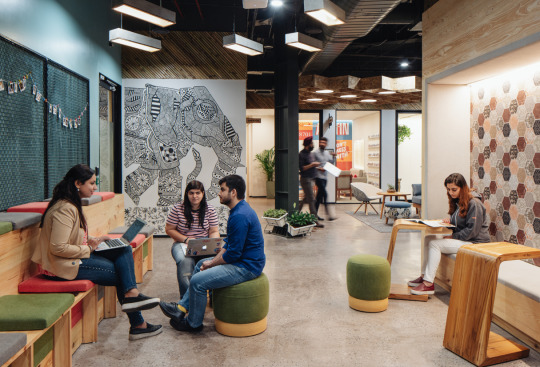
Collaborative office space designs are crucial for enhancing employee satisfaction and reducing turnover rates. Most organisations face these pressing challenges today, as employees have begun prioritising their well-being. Studies, too, indicate that companies actively promoting collaborative work environments witness a 50% reduction in employee turnover rates. Furthermore, such organisations experience a 17% increase in overall job satisfaction among their workforce.
Recognising these outcomes, organisations need to reevaluate and optimise their office spaces to encourage collaboration. The collaborative office space design concept has thus gained prominence as it strives to create an atmosphere conducive to teamwork and innovation.
But what exactly do such designs mean, and how do you achieve them? This article explores the top 10 office design ideas tailored to promote collaborative workspaces. We also list the tangible benefits and strategic considerations to remember when implementing such designs.
Ten design ideas for a collaborative workspace
Here are ten design ideas to consider for creating a collaborative workspace.
Open concept layouts
Embracing an open-concept layout is a foundational principle of collaborative office space design. Eliminating physical barriers, like cubicles and closed offices, helps promote spontaneous interactions among team members. It builds a sense of unity and transparency conducive to collaborative efforts. The design encourages the free flow of ideas and information to create an atmosphere where employees can easily engage with one another.
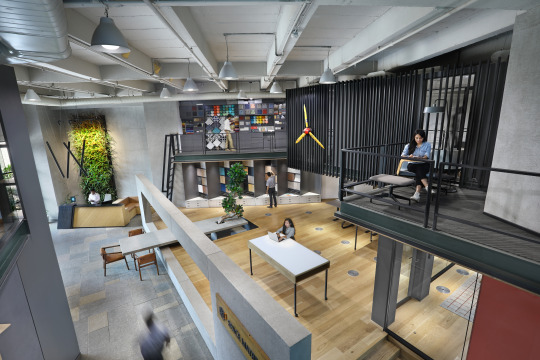
Flexible furniture arrangements
A productive office design should prioritise flexibility in furniture arrangements. Modular and adaptable furniture allows for easy reconfiguration of spaces to accommodate diverse work activities. Think of impromptu team meetings and individual-focused work. Versatility ensures the office layout remains responsive to the evolving needs of collaborative projects.
Collaboration zones
Designating specific areas as collaboration zones within the office reinforces the importance of teamwork. You can augment these spaces with comfortable seating, whiteboards, and other collaborative tools. It will become a dedicated space where employees can brainstorm and work collectively on projects. As an intentional design, it will create a culture of collaboration by offering purpose-built environments.
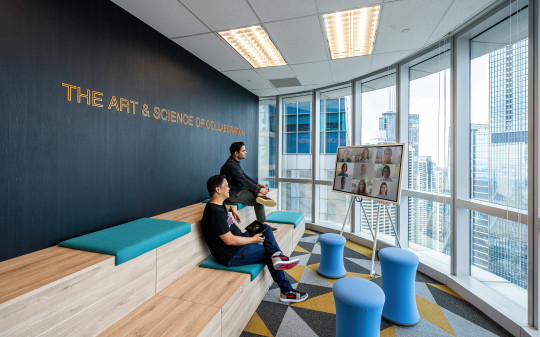
Technology integration
Incorporating advanced technology into the collaborative office space design is essential for seamless communication and information sharing. Video conferencing facilities and interactive displays enhance the connectivity of team members, whether they are working in the same physical space or remotely. A technologically-empowered workspace helps improve employee experience by enhancing collaboration.
Quiet spaces for focus
While collaboration is necessary, recognising the need for focused, individual work is equally crucial. Integrating quiet spaces or private pods within the office allows employees to retreat when concentration is essential. A balanced, collaborative office space design accommodates group dynamics and solitary productivity moments.

Biophilic design elements
Introducing elements of nature through biophilic design contributes to a more harmonious and productive office environment. Including natural light, plants, and other nature-inspired elements in the workspace enhances wellbeing. Furthermore, it helps reduce stress and promotes creativity. These are a must if you want to build a collaborative and dynamic work culture.
Agile workstations
Implementing agile workstations supports the diverse needs of collaborative projects. These workstations remain reconfigurable to accommodate various team sizes and work styles. The ability to adapt workspaces to specific tasks enhances efficiency. Additionally, it ensures the physical environment aligns with the collaborative nature of the work.
Inclusive design for accessibility
A genuinely collaborative workspace must be inclusive and accessible to all employees. Designing spaces that consider the diverse needs of individuals, including those with mobility challenges, ensures everyone can participate fully in collaborative activities. Inclusive design also promotes equality and belonging within the workspace.
Employee lounge areas
Providing comfortable and inviting lounge areas within the office creates informal spaces for employees to connect and collaborate. These areas can serve as hubs for casual discussions and team cohesion. A relaxed atmosphere in designated lounge spaces complements the more formal collaborative zones.
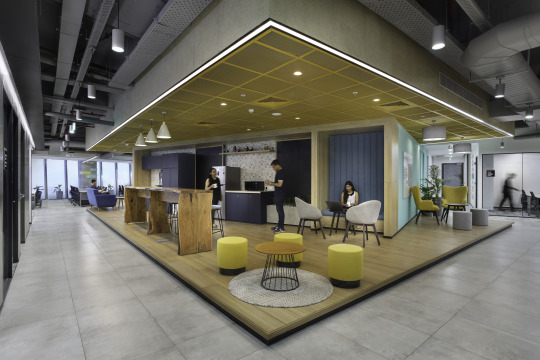
Transparent communication hubs
Establishing transparent communication hubs with digital displays and project boards enhances visibility into ongoing projects. These hubs act as centralised information points. They keep everyone informed about project progress, goals, and deadlines.
Role of technology in establishing collaborative workspaces
Technological integration plays a transformative role by enhancing communication and efficiency of collaborative efforts. Advanced technologies like video conferencing systems and interactive displays facilitate seamless interactions among team members when discussing a collaborative office space design.
These tools eliminate traditional communication barriers and promote real-time engagement and knowledge sharing. Moreover, technology enables the creation of intelligent work environments where employees can access information effortlessly and contribute to collaborative projects with enhanced efficiency. Ultimately, the strategic inclusion of technology into collaborative office space design augments the functionality of the workspace to promote innovation and adaptability.

Example of intelligent, collaborative workspaces in action
Kuehne+Nagel (K+N) is a global logistics company with independent Air Freight, Sea Freight, and Overland departments. It prioritises progress, collaboration, efficiency, and commitment. For their office revamp project, Space Matrix proposed a design concept that promotes organisational unity. The emphasis was on connectivity through social spaces that encourage collaboration while maintaining inter-departmental confidentiality.
The office features a continuous journey with thematic destinations, using gentle, flowing, curvilinear designs to create a sense of movement and pauses. Third Spaces facilitate serendipitous moments by incorporating technologically sound areas for informal meetings. The design intelligently links diverse spaces under one cloud, showcasing state-of-the-art services and class through carefully chosen materials and furniture.
Take the next steps for your dream collaborative workspace today
The office design ideas discussed here showcase the importance of intentional, collaborative office space design in enhancing employee satisfaction and reducing turnover rates. If you want to take the next steps towards achieving well-designed workspaces, consider the role of design agencies, like Space Matrix, specialising in collaborative office space design.
We can help you translate these concepts into tangible, functional realities. Our design principles will ensure your collaborative ethos seamlessly integrates into the physical work environment. Let's create futuristic workspaces that optimise functionality and cultivate a culture of teamwork and shared success.
#design concept#Technological integration#modern office ideas#space matrix#space matrix service#office modern design#space matrix designing#modern office interior design#workplace designs#workplace interiors#office interior design#workplace stratergy#technologically-empowered workspace#productive office design#open-concept layout#collaborative office space design#Top 10 Office Design Ideas
0 notes
Text
The Promising Future of the Yacht Chartering and Rental Market
The yacht chartering and rental market is poised for substantial growth, with companies like Sailogy SA and Antlos SRL leading the way. In this article, we will explore the factors contributing to this surge in revenue and the potential opportunities for investors in this thriving industry. Embracing the Luxurious Experience Yacht chartering offers a unique and opulent experience for those…

View On WordPress
#Antlos SRL#Geographical expansion#High-net-worth individuals#Investment opportunities#Luxury travel experiences#Private yacht charters#Sailogy SA#Technological integration#Yacht chartering#Yacht rental market
0 notes
Text
Autoenshittification
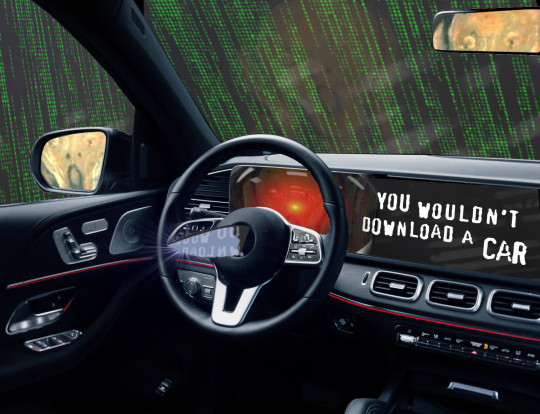
Forget F1: the only car race that matters now is the race to turn your car into a digital extraction machine, a high-speed inkjet printer on wheels, stealing your private data as it picks your pocket. Your car’s digital infrastructure is a costly, dangerous nightmare — but for automakers in pursuit of postcapitalist utopia, it’s a dream they can’t give up on.
Your car is stuffed full of microchips, a fact the world came to appreciate after the pandemic struck and auto production ground to a halt due to chip shortages. Of course, that wasn’t the whole story: when the pandemic started, the automakers panicked and canceled their chip orders, only to immediately regret that decision and place new orders.
But it was too late: semiconductor production had taken a serious body-blow, and when Big Car placed its new chip orders, it went to the back of a long, slow-moving line. It was a catastrophic bungle: microchips are so integral to car production that a car is basically a computer network on wheels that you stick your fragile human body into and pray.
The car manufacturers got so desperate for chips that they started buying up washing machines for the microchips in them, extracting the chips and discarding the washing machines like some absurdo-dystopian cyberpunk walnut-shelling machine:
https://www.autoevolution.com/news/desperate-times-companies-buy-washing-machines-just-to-rip-out-the-chips-187033.html
These digital systems are a huge problem for the car companies. They are the underlying cause of a precipitous decline in car quality. From touch-based digital door-locks to networked sensors and cameras, every digital system in your car is a source of endless repair nightmares, costly recalls and cybersecurity vulnerabilities:
https://www.reuters.com/business/autos-transportation/quality-new-vehicles-us-declining-more-tech-use-study-shows-2023-06-22/
What’s more, drivers hate all the digital bullshit, from the janky touchscreens to the shitty, wildly insecure apps. Digital systems are drivers’ most significant point of dissatisfaction with the automakers’ products:
https://www.theverge.com/23801545/car-infotainment-customer-satisifaction-survey-jd-power
Even the automakers sorta-kinda admit that this is a problem. Back in 2020 when Massachusetts was having a Right-to-Repair ballot initiative, Big Car ran these unfuckingbelievable scare ads that basically said, “Your car spies on you so comprehensively that giving anyone else access to its systems will let murderers stalk you to your home and kill you:
https://pluralistic.net/2020/09/03/rip-david-graeber/#rolling-surveillance-platforms
But even amid all the complaining about cars getting stuck in the Internet of Shit, there’s still not much discussion of why the car-makers are making their products less attractive, less reliable, less safe, and less resilient by stuffing them full of microchips. Are car execs just the latest generation of rubes who’ve been suckered by Silicon Valley bullshit and convinced that apps are a magic path to profitability?
Nope. Car execs are sophisticated businesspeople, and they’re surfing capitalism’s latest — and last — hot trend: dismantling capitalism itself.
Now, leftists have been predicting the death of capitalism since The Communist Manifesto, but even Marx and Engels warned us not to get too frisky: capitalism, they wrote, is endlessly creative, constantly reinventing itself, re-emerging from each crisis in a new form that is perfectly adapted to the post-crisis reality:
https://www.nytimes.com/2022/10/31/books/review/a-spectre-haunting-china-mieville.html
But capitalism has finally run out of gas. In his forthcoming book, Techno Feudalism: What Killed Capitalism, Yanis Varoufakis proposes that capitalism has died — but it wasn’t replaced by socialism. Rather, capitalism has given way to feudalism:
https://www.penguin.co.uk/books/451795/technofeudalism-by-varoufakis-yanis/9781847927279
Under capitalism, capital is the prime mover. The people who own and mobilize capital — the capitalists — organize the economy and take the lion’s share of its returns. But it wasn’t always this way: for hundreds of years, European civilization was dominated by rents, not markets.
A “rent” is income that you get from owning something that other people need to produce value. Think of renting out a house you own: not only do you get paid when someone pays you to live there, you also get the benefit of rising property values, which are the result of the work that all the other homeowners, business owners, and residents do to make the neighborhood more valuable.
The first capitalists hated rent. They wanted to replace the “passive income” that landowners got from taxing their serfs’ harvest with active income from enclosing those lands and grazing sheep in order to get wool to feed to the new textile mills. They wanted active income — and lots of it.
Capitalist philosophers railed against rent. The “free market” of Adam Smith wasn’t a market that was free from regulation — it was a market free from rents. The reason Smith railed against monopolists is because he (correctly) understood that once a monopoly emerged, it would become a chokepoint through which a rentier could cream off the profits he considered the capitalist’s due:
https://locusmag.com/2021/03/cory-doctorow-free-markets/
Today, we live in a rentier’s paradise. People don’t aspire to create value — they aspire to capture it. In Survival of the Richest, Doug Rushkoff calls this “going meta”: don’t provide a service, just figure out a way to interpose yourself between the provider and the customer:
https://pluralistic.net/2022/09/13/collapse-porn/#collapse-porn
Don’t drive a cab, create Uber and extract value from every driver and rider. Better still: don’t found Uber, invest in Uber options and extract value from the people who invest in Uber. Even better, invest in derivatives of Uber options and extract value from people extracting value from people investing in Uber, who extract value from drivers and riders. Go meta.
This is your brain on the four-hour-work-week, passive income mind-virus. In Techno Feudalism, Varoufakis deftly describes how the new “Cloud Capital” has created a new generation of rentiers, and how they have become the richest, most powerful people in human history.
Shopping at Amazon is like visiting a bustling city center full of stores — but each of those stores’ owners has to pay the majority of every sale to a feudal landlord, Emperor Jeff Bezos, who also decides which goods they can sell and where they must appear on the shelves. Amazon is full of capitalists, but it is not a capitalist enterprise. It’s a feudal one:
https://pluralistic.net/2022/11/28/enshittification/#relentless-payola
This is the reason that automakers are willing to enshittify their products so comprehensively: they were one of the first industries to decouple rents from profits. Recall that the reason that Big Car needed billions in bailouts in 2008 is that they’d reinvented themselves as loan-sharks who incidentally made cars, lending money to car-buyers and then “securitizing” the loans so they could be traded in the capital markets.
Even though this strategy brought the car companies to the brink of ruin, it paid off in the long run. The car makers got billions in public money, paid their execs massive bonuses, gave billions to shareholders in buybacks and dividends, smashed their unions, fucked their pensioned workers, and shipped jobs anywhere they could pollute and murder their workforce with impunity.
Car companies are on the forefront of postcapitalism, and they understand that digital is the key to rent-extraction. Remember when BMW announced that it was going to rent you the seatwarmer in your own fucking car?
https://pluralistic.net/2020/07/02/big-river/#beemers
Not to be outdone, Mercedes announced that they were going to rent you your car’s accelerator pedal, charging an extra $1200/year to unlock a fully functional acceleration curve:
https://www.theverge.com/2022/11/23/23474969/mercedes-car-subscription-faster-acceleration-feature-price
This is the urinary tract infection business model: without digitization, all your car’s value flowed in a healthy stream. But once the car-makers add semiconductors, each one of those features comes out in a painful, burning dribble, with every button on that fakakta touchscreen wired directly into your credit-card.
But it’s just for starters. Computers are malleable. The only computer we know how to make is the Turing Complete Von Neumann Machine, which can run every program we know how to write. Once they add networked computers to your car, the Car Lords can endlessly twiddle the knobs on the back end, finding new ways to extract value from you:
https://doctorow.medium.com/twiddler-1b5c9690cce6
That means that your car can track your every movement, and sell your location data to anyone and everyone, from marketers to bounty-hunters looking to collect fees for tracking down people who travel out of state for abortions to cops to foreign spies:
https://www.vice.com/en/article/n7enex/tool-shows-if-car-selling-data-privacy4cars-vehicle-privacy-report
Digitization supercharges financialization. It lets car-makers offer subprime auto-loans to desperate, poor people and then killswitch their cars if they miss a payment:
https://www.youtube.com/watch?v=4U2eDJnwz_s
Subprime lending for cars would be a terrible business without computers, but digitization makes it a great source of feudal rents. Car dealers can originate loans to people with teaser rates that quickly blow up into payments the dealer knows their customer can’t afford. Then they repo the car and sell it to another desperate person, and another, and another:
https://pluralistic.net/2022/07/27/boricua/#looking-for-the-joke-with-a-microscope
Digitization also opens up more exotic options. Some subprime cars have secondary control systems wired into their entertainment system: miss a payment and your car radio flips to full volume and bellows an unstoppable, unmutable stream of threats. Tesla does one better: your car will lock and immobilize itself, then blare its horn and back out of its parking spot when the repo man arrives:
https://tiremeetsroad.com/2021/03/18/tesla-allegedly-remotely-unlocks-model-3-owners-car-uses-smart-summon-to-help-repo-agent/
Digital feudalism hasn’t stopped innovating — it’s just stopped innovating good things. The digital device is an endless source of sadistic novelties, like the cellphones that disable your most-used app the first day you’re late on a payment, then work their way down the other apps you rely on for every day you’re late:
https://restofworld.org/2021/loans-that-hijack-your-phone-are-coming-to-india/
Usurers have always relied on this kind of imaginative intimidation. The loan-shark’s arm-breaker knows you’re never going to get off the hook; his goal is in intimidating you into paying his boss first, liquidating your house and your kid’s college fund and your wedding ring before you default and he throws you off a building.
Thanks to the malleability of computerized systems, digital arm-breakers have an endless array of options they can deploy to motivate you into paying them first, no matter what it costs you:
https://pluralistic.net/2021/04/02/innovation-unlocks-markets/#digital-arm-breakers
Car-makers are trailblazers in imaginative rent-extraction. Take VIN-locking: this is the practice of adding cheap microchips to engine components that communicate with the car’s overall network. After a new part is installed in your car, your car’s computer does a complex cryptographic handshake with the part that requires an unlock code provided by an authorized technician. If the code isn’t entered, the car refuses to use that part.
VIN-locking has exploded in popularity. It’s in your iPhone, preventing you from using refurb or third-party replacement parts:
https://doctorow.medium.com/apples-cement-overshoes-329856288d13
It’s in fuckin’ ventilators, which was a nightmare during lockdown as hospital techs nursed their precious ventilators along by swapping parts from dead systems into serviceable ones:
https://www.vice.com/en/article/3azv9b/why-repair-techs-are-hacking-ventilators-with-diy-dongles-from-poland
And of course, it’s in tractors, along with other forms of remote killswitch. Remember that feelgood story about John Deere bricking the looted Ukrainian tractors whose snitch-chips showed they’d been relocated to Russia?
https://doctorow.medium.com/about-those-kill-switched-ukrainian-tractors-bc93f471b9c8
That wasn’t a happy story — it was a cautionary tale. After all, John Deere now controls the majority of the world’s agricultural future, and they’ve boobytrapped those ubiquitous tractors with killswitches that can be activated by anyone who hacks, takes over, or suborns Deere or its dealerships.
Control over repair isn’t limited to gouging customers on parts and service. When a company gets to decide whether your device can be fixed, it can fuck you over in all kinds of ways. Back in 2019, Tim Apple told his shareholders to expect lower revenues because people were opting to fix their phones rather than replace them:
https://www.apple.com/newsroom/2019/01/letter-from-tim-cook-to-apple-investors/
By usurping your right to decide who fixes your phone, Apple gets to decide whether you can fix it, or whether you must replace it. Problem solved — and not just for Apple, but for car makers, tractor makers, ventilator makers and more. Apple leads on this, even ahead of Big Car, pioneering a “recycling” program that sees trade-in phones shredded so they can’t possibly be diverted from an e-waste dump and mined for parts:
https://www.vice.com/en/article/yp73jw/apple-recycling-iphones-macbooks
John Deere isn’t sleeping on this. They’ve come up with a valuable treasure they extract when they win the Right-to-Repair: Deere singles out farmers who complain about its policies and refuses to repair their tractors, stranding them with six-figure, two-ton paperweight:
https://pluralistic.net/2022/05/31/dealers-choice/#be-a-shame-if-something-were-to-happen-to-it
The repair wars are just a skirmish in a vast, invisible fight that’s been waged for decades: the War On General-Purpose Computing, where tech companies use the law to make it illegal for you to reconfigure your devices so they serve you, rather than their shareholders:
https://memex.craphound.com/2012/01/10/lockdown-the-coming-war-on-general-purpose-computing/
The force behind this army is vast and grows larger every day. General purpose computers are antithetical to technofeudalism — all the rents extracted by technofeudalists would go away if others (tinkereres, co-ops, even capitalists!) were allowed to reconfigure our devices so they serve us.
You’ve probably noticed the skirmishes with inkjet printer makers, who can only force you to buy their ink at 20,000% markups if they can stop you from deciding how your printer is configured:
https://pluralistic.net/2022/08/07/inky-wretches/#epson-salty But we’re also fighting against insulin pump makers, who want to turn people with diabetes into walking inkjet printers:
https://pluralistic.net/2022/06/10/loopers/#hp-ification
And companies that make powered wheelchairs:
https://pluralistic.net/2022/06/08/chair-ish/#r2r
These companies start with people who have the least agency and social power and wreck their lives, then work their way up the privilege gradient, coming for everyone else. It’s called the “shitty technology adoption curve”:
https://pluralistic.net/2022/08/21/great-taylors-ghost/#solidarity-or-bust
Technofeudalism is the public-private-partnership from hell, emerging from a combination of state and private action. On the one hand, bailing out bankers and big business (rather than workers) after the 2008 crash and the covid lockdown decoupled income from profits. Companies spent billions more than they earned were still wildly profitable, thanks to those public funds.
But there’s also a policy dimension here. Some of those rentiers’ billions were mobilized to both deconstruct antitrust law (allowing bigger and bigger companies and cartels) and to expand “IP” law, turning “IP” into a toolsuite for controlling the conduct of a firm’s competitors, critics and customers:
https://locusmag.com/2020/09/cory-doctorow-ip/
IP is key to understanding the rise of technofeudalism. The same malleability that allows companies to “twiddle” the knobs on their services and keep us on the hook as they reel us in would hypothetically allow us to countertwiddle, seizing the means of computation:
https://pluralistic.net/2023/04/12/algorithmic-wage-discrimination/#fishers-of-men
The thing that stands between you and an alternative app store, an interoperable social media network that you can escape to while continuing to message the friends you left behind, or a car that anyone can fix or unlock features for is IP, not technology. Under capitalism, that technology would already exist, because capitalists have no loyalty to one another and view each other’s margins as their own opportunities.
But under technofeudalism, control comes from rents (owning things), not profits (selling things). The capitalist who wants to participate in your iPhone’s “ecosystem” has to make apps and submit them to Apple, along with 30% of their lifetime revenues — they don’t get to sell you jailbreaking kit that lets you choose their app store.
Rent-seeking technology has a holy grail: control over “ring zero” — the ability to compel you to configure your computer to a feudalist’s specifications, and to verify that you haven’t altered your computer after it came into your possession:
https://pluralistic.net/2022/01/30/ring-minus-one/#drm-political-economy
For more than two decades, various would-be feudal lords and their court sorcerers have been pitching ways of doing this, of varying degrees of outlandishness.
At core, here’s what they envision: inside your computer, they will nest another computer, one that is designed to run a very simple set of programs, none of which can be altered once it leaves the factory. This computer — either a whole separate chip called a “Trusted Platform Module” or a region of your main processor called a secure enclave — can tally observations about your computer: which operating system, modules and programs it’s running.
Then it can cryptographically “sign” these observations, proving that they were made by a secure chip and not by something you could have modified. Then you can send this signed “attestation” to someone else, who can use it to determine how your computer is configured and thus whether to trust it. This is called “remote attestation.”
There are some cool things you can do with remote attestation: for example, two strangers playing a networked video game together can use attestations to make sure neither is running any cheat modules. Or you could require your cloud computing provider to use attestations that they aren’t stealing your data from the server you’re renting. Or if you suspect that your computer has been infected with malware, you can connect to someone else and send them an attestation that they can use to figure out whether you should trust it.
Today, there’s a cool remote attestation technology called “PrivacyPass” that replaces CAPTCHAs by having you prove to your own device that you are a human. When a server wants to make sure you’re a person, it sends a random number to your device, which signs that number along with its promise that it is acting on behalf of a human being, and sends it back. CAPTCHAs are all kinds of bad — bad for accessibility and privacy — and this is really great.
But the billions that have been thrown at remote attestation over the decades is only incidentally about solving CAPTCHAs or verifying your cloud server. The holy grail here is being able to make sure that you’re not running an ad-blocker. It’s being able to remotely verify that you haven’t disabled the bossware your employer requires. It’s the power to block someone from opening an Office365 doc with LibreOffice. It’s your boss’s ability to ensure that you haven’t modified your messaging client to disable disappearing messages before he sends you an auto-destructing memo ordering you to break the law.
And there’s a new remote attestation technology making the rounds: Google’s Web Environment Integrity, which will leverage Google’s dominance over browsers to allow websites to block users who run ad-blockers:
https://github.com/RupertBenWiser/Web-Environment-Integrity
There’s plenty else WEI can do (it would make detecting ad-fraud much easier), but for every legitimate use, there are a hundred ways this could be abused. It’s a technology purpose-built to allow rent extraction by stripping us of our right to technological self-determination.
Releasing a technology like this into a world where companies are willing to make their products less reliable, less attractive, less safe and less resilient in pursuit of rents is incredibly reckless and shortsighted. You want unauthorized bread? This is how you get Unauthorized Bread:
https://arstechnica.com/gaming/2020/01/unauthorized-bread-a-near-future-tale-of-refugees-and-sinister-iot-appliances/amp/

If you'd like an essay-formatted version of this thread to read or share, here's a link to it on pluralistic.net, my surveillance-free, ad-free, tracker-free blog:
https://pluralistic.net/2023/07/24/rent-to-pwn/#kitt-is-a-demon

[Image ID: The interior of a luxury car. There is a dagger protruding from the steering wheel. The entertainment console has been replaced by the text 'You wouldn't download a car,' in MPAA scare-ad font. Outside of the windscreen looms the Matrix waterfall effect. Visible in the rear- and side-view mirror is the driver: the figure from Munch's 'Scream.' The screen behind the steering-wheel has been replaced by the menacing red eye of HAL9000 from Stanley Kubrick's '2001: A Space Odyssey.']

Image: Cryteria (modified) https://commons.wikimedia.org/wiki/File:HAL9000.svg
CC BY 3.0 https://creativecommons.org/licenses/by/3.0/deed.en
#pluralistic#shitty technology adoption curve#unauthorized bread#automotive#arm-breakers#cars#big car#right to repair#rent-seeking#digital feudalism#neofeudalism#drm#wei#remote attestation#private access tokens#yannis varoufakis#web environment integrity#paternalism#war on general purpose computing#competitive compatibility#google#enshittification#interoperability#adversarial interoperability#comcom#the internet con#postcapitalism#ring zero#care#med-tech
4K notes
·
View notes
Text
Twitch Integration Part A, Customer Swap Stories #3
Special Thanks to @changinghands for submitting these images!
Recently, Twitch introduced a new integration with Swap Tech Enterprise that when enabled, at the end of the stream the highest donator would swap bodies with the streamer for a predetermined amount of time on the streamers end. John had heard about this and immediately started looking for a stream that had this enabled so that he could potentially experience a real life body swap. As he looked through all the current streams happening with the feature enabled, he came across dollthighs stream.

As people joined his stream, he let them know about the new feature and that he has currently enabled it. He also informed them that once the stream ended, the top donator would get to spend 2 days in his body, allowing them the chance to lead a stream on their own before switching back. John knew this would be the body he wanted to experience for a couple of days and joined the stream. Immediately, donations started to pour in and before he knew it, thousands of people will jumping on the chance to have just a couple of days in dollthighs body. As the stream started to come to an end, John sent a donation for 5,000 dollars came in, the highest dollthighs had ever seen in his time streaming.

“Well it looks like we have a winner!” dollthighs said as the notification popped. He mentioned that he would be ending the stream now and that the donator could expect to be in his body within the next couple of minutes. Once the stream ended, a notification popped up on John’s end stating that dollthighs had accepted the terms and conditions of the swap, and now all that was needed was his acceptance of the terms and conditions as well. He quickly skimmed through the terms and conditions and accepted them. Before he knew it everything went dark. As he came to, John noticed he was no longer in his room, but in a room where the walls to the ceiling were covered in dolls! He knew the swap must have worked and quickly ran to the bathroom. Looking at his new reflection in the mirror, he began to rip off his clothes in excitement!

“This is going to be the best 2 days of my life” John exclaimed as he ran back to computer to start up a stream and play some video games!
#body swap#body swap technology#body switch#male body swap#male tf#male transformation#customer swap stories#ste series#mtm body swap#twitch integration#image submission
149 notes
·
View notes
Text
I hate websites I hate managing websites so much. I'm always clenching my fists waiting for the day GTW completely breaks. I just wanna draw comics man.
#the plugin I'm using has been unsupported for years#and I'm like...waiting for the axe to fall#it seems like the only one being regularly updated is one that caters more to the webtoon kind of format#and the second I read about how to integrate things my eyes glaze over I HATE computers#Dunno how they work...don't want to fuck with things lest my shoestring whatever completely collapses#so I just cross my fingers and hope nothing catastrophic happens#god i wish i could apply to hiveworks or something#I could look into transitioning to comic fury or something but that just...I don't want to start over again#I just want something that's Actually Fuckin Supported but i guess the nature of technology is it'll never be stable for more than 10 years
103 notes
·
View notes
Text
🌟 Charming Princess Anne and Sir Tim at the Royal Hospital Chelsea's Founders Day ceremony today.





#GOAT COUPLE PRINCESS ROYAL AND VICE ADMIRAL SIR TIMOTHY LAURENCE#Mr &Mrs Timothy Laurence#Busy Bee 🐝 Princess Royal and Vice Admiral Sir Timothy Laurence#the heartbeat of the British Royal family#Princess Anne#Princess Royal#Technological integrated man servant#Tim Laurence#Timothy Laurence#British Royal family
49 notes
·
View notes
Text
the fact of the matter is that given the current state of both the art industry and the legal landscape of copyright/ip law, there will not ever be legislation around AI image generation that restricts companies while benefiting independent artists. rather than pushing for formal legal weigh-ins on what does or does not qualify as theft by generative outputs (i still think there could be something to be said about what companies are legally allowed to input into their generative models) we really just need to continue to. well. use our brains.
i may be in the minority in that i believe there are plenty of ways to use generative models as a tool in your artistic process (rather than being a replacement for an artistic process) that doesn't infringe on the work or livelihood of your fellow artists. and rather than wasting energy on trying to shove this genie back into the bottle, which, will not ever happen, we should work on publicly discussing where these boundaries lie. and we should also, without question, continue giving major shit to companies who are using AI generated images to avoid paying artists.
#ive seen a lot of people who seem to be of the sentiment that generative images are comparable to the NFT fad and will just disappear soon#and while the hype will undoubtedly die down#this is not a technology we are ever getting rid of. so we have to learn how to integrate it into the larger culture of independent artmaki#if we fully refuse to participate in the ai discussion beyond 'all use of image generation is unforgivable'#then we de facto cede the development of social norms for acceptable use for AI images to corporations and other non-artists#going scorched earth on this one isnt gonna work guys! it just wont!
177 notes
·
View notes
Text

#The Faction#Malware#Galvanic Mechamorph#Technology Integration#Technology Augmentation#Ben 10#Autobot Academy
10 notes
·
View notes
Text
Make Use Of Me (chapter 1, preview)
Dec. 7 EDIT: ONCE MORE, WITH BRAVERY THIS TIME. No more chickening out. You can read this thing FOR REAL now. Sorry for being weird, and now....sorry if this wasn't worth it. XD
O-OK...here goes....
First thing's first: I am not expecting a lotta people to read this. I'm not asking people to read this. At this point, I'm making this mostly as a passion project, and if anyone enjoys it, it'll be a really cool bonus. My writing style isn't gonna be for everyone, and the characters I write aren't the most....popular characters in the CRK X Reader community, and I imagine this isn't really something a lotta fans'll be demanding more of.
This is LONG. This one chapter is 56 pages long. I am a VERY wordy writer,
So......why'm I posting this preview? Well....partially as an interest gauge for people who WOULD wanna read it, but...mostly as a motivator. As something to remind myself of whenever I get lazy. After all....I can't quit after I made the first chapter public, right? By doing that, I put myself out there...And, hey, I even tagged it, so, if by the off chance, someone did read it, I'm basically promising them more eventually.....
But, again, I'm not forcing anyone to read this.
Not only is it long, but.....This first chapter is probably my least-favorite thing I've ever written. By posting this chapter by itself, I'm testing to see if it does its job of making people wanna read the rest, cuz....right now, I'm not so sure how well it succeeds at that.....
This is the boring part of the story. It's a bunch of setup, and me jumping through hoop after hoop after hoop to just get everything started. I know setup is important and all, but....I'm already a very wordy writer, so....oof....There is some interesting stuff that happens, but it takes a while to get there.
I-I....kinda hate it, actually. The only reason I didn't scrap it is that I didn't realize I hated it until I was about halfway through it and the "good part" hadn't started yet. And I still spent a month writing the thing, so....I finished it.
I'm tagging this...as an experiment. If you wanna read this, go ahead. W-well, read my tags first, THEN go ahead. XD
All I can really say in this chapter's defense is that....I do try my best to salvage it. It's just setup, but I TRIED to make it interesting. And everything that seems like it didn't go anywhere, will later. This isn't the whole story, it's just the beginning of what's gonna be a BIG story. Anything that seems weird in this chapter, gets explored in the other chapters. This does set up a bunch of stuff that becomes important later (The friend character shows up later, the Colosseum becomes relevant later). This chapter is boring, but I tried not to make any of it pointless.
For the future: I'm aiming for five chapters. Chapters 2 and 3 will be a series of smaller vignettes that take place over the course of a few years, chapter 4 will be the climax, and chapter 5 will be something of an epilogue. After that, there will be two endings to choose from (which will make sense when we get there).
This probably won't be my favorite thing I've ever written, but it will be the most ambitious thing I've ever, and probably will ever, write. I haven't written something like this before, and it's all to flesh out this story and make it believable.
Right now, I.....I want to finish this. I'll probably still be writing this in February at the rate I'm going, but...at this point, I've put too much into it to give up on it. However, I'm STILL not completely ruling out the idea of my motivation dying before then. It COULD happen. So, what I'm planning to do is...setting a short-term goal of finishing chapter 3. After I do that, I'll post the first three chapters on AO3 together, and work on the rest. That way, even if I don't finish it, I'll at least have it over half done, and chapter 3 will end on a somewhat high note.
So, yyyyeah....Not a lotta people will read this preview. Overly wordy writing style + boring setup part of story + 56 pages long + assumed lack of interest for X Readers of this character (At least, I haven't SEEN many simps for her, m-maybe I'm wrong, I might be, I-I haven't checked any tags cuz I've been nervous, b-but it doesn't make my writing any better. In that case, this is my first time writing her so I'm trying super hard to do her justice >//////<)
I-if you wanna read this, and see if this first chapter does a good job of making you wanna read the better chapters, then...Go ahead.....
Some notes:
-This is still not the final draft. It's finalized enough for me to share, but I'm still not considering it finished. Even tho I'm working on chapter 3 right now, I STILL go back and edit this, even very recently. So, chances are, even if the story is finalized, small details and sentences are still subject to change. I know for a fact that there are still SOME placeholder bits in here that will change after I get some stuff cleared up. Recently, I even considered chopping off an entire section to make it shorter. I decided not to, but hey, it could still happen. I don't wanna waste anyone's time. The first chapter of a story, even if it's boring, is still very important, and I wanna make sure it's the best version of itself.
(A-and yes, this means that I've finished chapter 2 as well. The reason I'm not sharing it is that, unlike chapter 1, it was finished VERY recently, so I might still need to give myself time to edit it. From what I have, tho, I do like it a LOT more than chapter 1. There are some parts of chapter 2 that I'm legit proud of.)
-Even tho this first chapter is completely clean, I-I should mention that....this fic is for adults. The full version, at least. Chapters 3 and 4 are gonna contain some light N/S/F/W moments (the "fade to black" variety, so nothing explicit) and there'll be other slightly racey comments here and there. Just a heads-up. I'm gonna be uncomfy with minors reading this.
Th-that's all? I-I think that's all.......O-OK, so......h-here goes..... E-enjoy....
#fanfic preview#WARNING: UNFINISHED#THIS IS JUST THE FIRST CHAPTER#......AND ITS STILL A LONG READ#cookie run x reader#crk x reader#golden cheese cookie x reader#gender neutral reader#also contains a gender neutral 'friend' character you can do what you want with#basically i got inspired by that part in her bio that mentions how...#....shes always looking to add more loyal subjects#and it made me imagine the story of an outsider who gradually integrates into the kingdom and earns her approval#so its an underdog story basically#and there a LOT that the reader gets put through#reader is shy and socially awkward but can also be a bit more sarcastic than the other reader characters ive written#im aiming for a BIT more comedy than usual since its my first crk fic that doesnt take place in the humorless dark cacao kingdom XD#but yeah reader is a ball of anxiety#they get panic attacks later on#pre canon#VERY VERY VERY pre canon#takes place DECADES before canon#before um....the lost city became lost#its not virtual#no errors no avatars#just a technologically advanced city#power imbalance and god complex stuff all over the place cuz fghdhgfhdhfgh im weak for that part of her#also contains some themes of verbal abuse (from nameless characters toward reader)#and like i said it has some adult moments later on#contains a lot of time skips
29 notes
·
View notes
Text
Being his preferred weapon of choice, it did not take soundwave long to decide to undergo the necessary structural modifications to integrate the resonance blaster into his body as the integrated ranged weapon his forearms may reconfigure into. It certainly helps that as a devastating sonic weapon, the resonance blaster fits extremely well as an addition into the decepticon spy master's arsenal
#transformers#unified continuity#decepticon technology#resonance blaster#integrated weapons#soundwave
8 notes
·
View notes
Text

Tired of spreadsheets? Upgrade to Magtec ERP Software for streamlined business operations and data-driven decisions. Book a demo today and see how we can transform your business!
#magtec#erp#automation#business#efficiency#software#technology#innovation#digitaltransformation#enterprise#solutions#productivity#success#growth#management#finance#humanresources#supplychain#logistics#cloud#saas#onpremises#hybrid#integration#scalability#customization#support#trustedpartner#magtecerp#magtecsolutions
3 notes
·
View notes
Text
Anakin...



STAR WARS EPISODE II: Attack of the Clones 00:30:41
#Star Wars#Episode II#Attack of the Clones#Coruscant#Galactic City#Port District#Westport#Magnaline 3000 air transport#airbus#Anakin Skywalker#Senator Padmé Amidala#Obi-Wan Kenobi#Captain Gregar Typho#Dormé#Padawan braid#transparisteel#viewport#Secure-A3 comlink#unidentified blaster pistol#unidentified freighter tramper#hardened comlink#Naboo Technologies#satellite uplink#signal booster#broadcast strength#shielded circuits#integrated active encryption
2 notes
·
View notes
Text
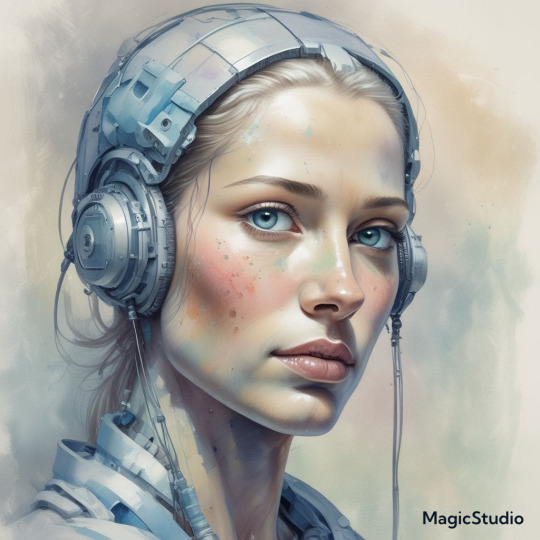
Humanity Amplified: The Emerging Era of AI Integration
The transformative ascent of Artificial Intelligence (AI) is a narrative of sustained innovation, culminating in a technology that is redefining the boundaries of human capability. Unlike the oft-perceived notion of an overnight breakthrough, AI's evolution is the result of a fifteen-year journey of enhancing data analysis, computational power, and refining neural network architectures. Pivotal milestones, such as AlphaGo's triumph and the pioneering application of GPUs in deep learning, have illuminated AI's vast potential in navigating complex problems, thereby solidifying its position as a burgeoning partner in human progress.
AI's current state is marked by its emergence as a versatile predictive tool, adept at deciphering the intricacies of human decision-making with unprecedented accuracy. This predictive capability, underpinned by the governing scaling laws, promises to democratize access to knowledge and expertise, thereby empowering a diverse array of individuals. The forthcoming integration of AI as a personalized "co-pilot" – offering bespoke learning pathways, medical advisement, creative inspiration, and emotional support – heralds a future where technology is inextricably intertwined with the human experience.
A forthcoming critical juncture is the development of AI systems endowed with expansive memory capabilities, poised to transform interactions from ephemeral exchanges to profound, long-term relationships. Concurrently, the diminishing cost of computational power sets the stage for a global AI adoption, transcending linguistic and geographical divides. Notably, the anticipated support for a broader spectrum of languages underscores AI's potential to bridge cultural chasms and foster a more interconnected global community.
The future human-AI interface is characterized by the evolution of AI into a deeply empathetic and introspective conversational companion. Enhanced by its capacity for "Chain of Thought" processes, AI will engage in reflective and iterative response refinement, marking a significant leap towards crafting interactions that are both productive and profoundly personal. This novel plane of communication, facilitated by AI's real-time comprehension and response to human emotions and needs, will redefine the paradigms of creation, collaboration, and connection.
To fully leverage AI's transformative potential, embracing a multifaceted mindset is paramount. In an era where collective intelligence is amplified by ubiquitous connectivity, proficiency across a broad spectrum of technical and social disciplines will distinguish the most impactful individuals. This necessitates a balanced approach, combining specialized expertise with a breadth of knowledge, to innovate at the intersections of disparate disciplines.
As humanity embarks on this extraordinary journey, it is evident that AI's true potential lies in its capacity to elevate and enhance the human experience. By embracing this transformative power with a curious, adaptable, and multidisciplinary mindset, we can ensure that the dawn of the AI era illuminates a future marked by increased brightness, compassion, and wonder, ultimately enriching the lives of all individuals.
Mustafa Suleyman: An exclusive interaction with Microsoft's AI CEO (Times Techies, November 2024)
youtube
Sunday, November 17, 2024
#human ai collaboration#artificial intelligence future#innovation#technology#intelligence amplification#human experience#ai integration#future possibilities#human ai intersection#ai paradigm shift#intelligence augmentation#interview#ai assisted writing#machine art#Youtube
3 notes
·
View notes
Text
Every once in a while you find an absolutely brilliant scifi au on the fanfiction website with the most perfectly made first 7 out of 8 chapters, only to find that the final chapter 8 consists of a long and unhinged sex scene and little else. And you have to still bookmark the thing because the au is still brilliant and you cannot let it go (and also because you may be aroace but you are not weak and you refuse to be defeated by sex scenes)
#there was very interesting use of advanced ai as both an antagonistic force and a tool and ally#i will be adding something like that but of slightly more magical nature into my own fictional nonsense#also made me wonder about biotechnology and how to integrate my fictional world's half-magical technology with living beings#such as replacement limbs#or organs#also to what degree i would allow adding or enhancing features on living beings to go#also limitations and costs and consequences
2 notes
·
View notes
Text
Technology Integration Education Research A New Era
Technology Integration Education Research era has revolutionized the manner college students examine and teachers coach. From interactive digital gear and virtual classrooms to artificial intelligence (AI) and information-driven insights, generation is reshaping schooling on a global scale. This transformation is going beyond replacing conventional chalkboards with smartboards or textbooks with capsules. It offers a extra dynamic, personalized, and efficient studying experience that prepares college students for the demands of the twenty first-century workforce. As we discover the profound effect of technology integration in education, we're going to have a look at its advantages, challenges, and the approaches it's far shaping the future of mastering.

The Evolution of Technology in Education
Historically, education has been characterized by using traditional techniques of practice, which include lectures, textbooks, and hands-on activities. While these stay treasured, the appearance of era has brought a wealth of recent tools and assets that enhance the coaching and learning manner.
Technology in education began with the introduction of computers and the internet in classrooms, but it has on account that advanced into an atmosphere that includes smart gadgets, academic software program, on-line gaining knowledge of systems, and virtual studying environments. Schools and universities now contain era in multiple ways, from mixed getting to know models to fully on-line courses. This evolution allows for extra interactive, bendy, and reachable schooling for inexperienced persons of all ages.
The Benefits of Technology Integration in Education
Personalized Learning:
One of the most huge benefits of generation in schooling is its capability to facilitate customized gaining knowledge of reviews. With the assist of AI and system gaining knowledge of algorithms, educational platforms can tailor classes, quizzes, and exercises to individual college students’ learning speeds and patterns. This guarantees that each scholar gets guidance at their own tempo, minimizing frustration and maximizing comprehension.
Tools like adaptive getting to know software program analyze a scholar's progress and offer focused content that addresses their particular wishes. For instance, a pupil suffering with math can obtain extra practice troubles, at the same time as a greater advanced scholar is probably challenged with higher-degree questions.
Enhanced Engagement:
Interactive tools including instructional games, simulations, and multimedia content material make studying greater attractive and fun for students. Visual and audio elements help explain complicated concepts in approaches that conventional strategies won't, making studying extra reachable to visual and auditory inexperienced persons.
Virtual Reality (VR) and Augmented Reality (AR) are also more and more being utilized in lecture rooms to create immersive studying studies. Students can discover historical civilizations, visit outer area, or dissect virtual animals, all with out leaving the study room. These gear captivate students’ interest and make gaining knowledge of more memorable.
Collaboration and Communication:
Technology enables collaboration amongst students, instructors, and even worldwide friends. Tools like Google Classroom, Microsoft Teams, and Zoom allow for real-time communique, document sharing, and collaborative tasks. Students can paintings collectively on assignments, talk thoughts, and supply peer feedback, regardless of their physical area.
In addition to pupil collaboration, era permits instructors to hold higher communication with students and mother and father. Online portals and apps offer instant updates on grades, assignments, and attendance, allowing for more obvious and ongoing feedback.
Accessibility and Inclusivity:
It has the capacity to make schooling more inclusive via offering get admission to to resources for students with disabilities. For example, display readers and textual content-to-speech software help visually impaired college students, whilst speech recognition equipment help students with bodily or getting to know disabilities take part extra completely in elegance.
Online guides and digital textbooks additionally allow students from remote or underserved areas to get entry to high-quality education. With the rise of Massive Open Online Courses (MOOCs), novices from around the arena can take publications from top universities without ever stepping foot on campus.
Global Learning Opportunities:
It breaks down geographical limitations, allowing college students to connect to friends, teachers, and experts from around the sector. Through digital exchanges, college students can engage in cross-cultural projects, discussions, and studies. This international angle complements students’ expertise of various cultures and fosters empathy, crucial thinking, and worldwide citizenship.
Moreover, online structures like Coursera, and Khan Academy offer college students get admission to to world-elegance schooling from pinnacle universities and establishments, regularly at little to no cost.
Data-Driven Insights:
Importance technology integration education affords educators with powerful equipment to collect and examine records on scholar performance. Learning control systems (LMS) and evaluation equipment generate unique reviews on student development, figuring out regions of electricity and people requiring in addition attention. This facts allows instructors to make knowledgeable decisions, adjust coaching techniques, and provide centered interventions to help student getting to know.
Predictive analytics also can help become aware of students who are vulnerable to falling behind, allowing instructors to interfere early and offer the vital help to preserve them on the right track.
2 notes
·
View notes
Text
HRH The Princess Royal paid her respects alongside Second World War veterans at Arnhem Oosterbeek Cemetery
HRH The Princess Royal reading The Lesson : Psalm 91 at The Airborne Memorial Service at Arnhem Oosterbeek War Cemetery







#netherlands 2024#GOAT COUPLE PRINCESS ROYAL AND VICE ADMIRAL SIR TIMOTHY LAURENCE#The heartbeat of the British Royal family#Mr & Mrs Timothy Laurence#Technological integrated man servant#always supporting his wife#Busy Bee 🐝 Princess Royal and Vice Admiral Sir Timothy Laurence#Boss Lady HRH Princess Royal and Vice Admiral Sir Timothy Laurence#Princess Royal#Princess Anne#Tim Laurence#Timothy Laurence#British Royal family
26 notes
·
View notes